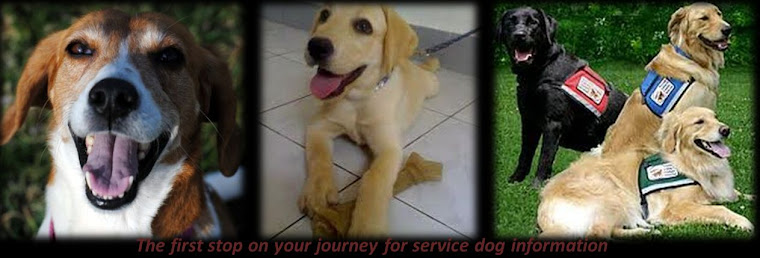 What comes
to mind when you think of a service or assistance dog? Many of us picture a beautiful golden or
Labrador retriever, or maybe a smaller breed, serving as a faithful helpmate to
someone who is disabled. Most think of
someone in a wheelchair or someone who’s blind.
A few of us think of someone whose disability is not readily apparent to
others such as diabetes, post-traumatic stress or brain injury. Some smile down at their own service dog
lying quietly at their feet.
What comes
to mind when you think of a service or assistance dog? Many of us picture a beautiful golden or
Labrador retriever, or maybe a smaller breed, serving as a faithful helpmate to
someone who is disabled. Most think of
someone in a wheelchair or someone who’s blind.
A few of us think of someone whose disability is not readily apparent to
others such as diabetes, post-traumatic stress or brain injury. Some smile down at their own service dog
lying quietly at their feet.
But some
folks must picture a sad, weary, downtrodden dog with the life of an indentured
servant. Last week, an application to
the Northern California Golden Retriever Rescue was turned down because it was
noted that the dog would be adopted for training as a service dog. The rescue group does not allow adoptions for
dogs that are destined for service work.
Apparently, they would rather the dog stay in their shelter or foster
home than find a loving, permanent home, simply because it would be highly
trained for service work.
A trainer recently
informed me that she did not “believe” in dogs working as service dogs. She was convinced that the dogs were
mistreated, overworked, and essentially had a horrible, really terrible life as
a service dog. Interestingly, she didn’t
feel that way about other types of working dogs such as those trained for bomb
and drug detection. Nothing I said could
convince her otherwise.
To be fair, there
are many rescue groups and shelters that not only support placing their dogs
as possible service dogs … they encourage it and will help trainers identify likely
candidates.
So what does
the typical life of a service dog look like?
I suspect there’s no real answer to that question. But, on average, service dogs have amazing
lives. They love and are loved
back. They get to go lots of places
other dogs don’t get to go. They play
and exercise and nap. They go swimming,
hiking and on vacation. They get lots of
treats. And every day they increase
independence and enhance the quality of life for the person they're lucky enough to love
and who love them back.
Isn’t that
better than staying in a shelter?
For more information about service dogs and their use for people with invisible disabilities, please visit our website at www.ServiceDog411.com.
For more information about service dogs and their use for people with invisible disabilities, please visit our website at www.ServiceDog411.com.
